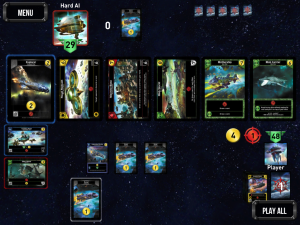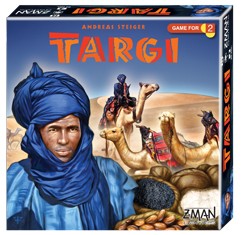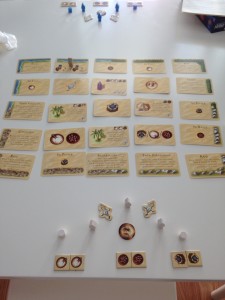Kahuna is on the old side for a Eurogame, debuting in 1997 under another name and appearing in its current form in 1998, making it one of the earliest titles in what is now known as the Kosmos two-player series, which includes Lost Cities, Targi, and Jambo. Kahuna hits a lot of the right notes for a two-player game, requiring a lot of interaction between players with a nice balance of strategy and luck, as the players compete to control areas of a map with twelve islands on it by playing cards that allow them to build bridges between islands or to blow up the other player’s bridges. Kahuna got the app treatment earlier this year from USM, the same publisher behind some of the Catan implementations, and it’s a great-looking version of the game that could use a much stronger AI opponent and a simple undo function to make it great. The iOS version appears to have come out first, with an Android release in August; both are $2.99.
The Kahuna board has the aforementioned dozen islands, with names that start with each letter from A to L, and various links connecting them on which players can build bridges. If you play a card with the name of any island, you can place one of your bridges on any link that has one end on that island. If you place your bridges on a majority of the links from any island – ranging from three to six total links depending on the island – you gain control of it, placing one of your stones on the island, and then removing any opponents’ bridges that connected to that island. You may also play two cards matching the islands connected by an opponent’s bridge (two of the same island, or one of each) to destroy it, which may in turn cost your opponent control of one or more islands. You can play any number of cards on a turn, but you are not required to play any cards at all, so you can stockpile cards up to your hand limit of five and then drop as many of those as you’d like for a power move that might, for example, blow up an opponent’s bridge and then steal control of one or more islands in one fell swoop.
The game has three rounds, and at the end of each round you compare the number of islands controlled by each player. Each round ends when the draw deck – there are 24 cards total, with three on display at any time – is exhausted. The leader after round one gets 1 point, after round two gets 2 points, and after round 3 gets a number of points equal to the difference in number of islands controlled, so a player can drop the first two rounds and still make a furious comeback in round three (although I don’t recommend this as a strategy).
The app version ran very smoothly for me through a few dozen plays, and the graphics are bright and clear, with just a minimum of text required to play (you just need to be able to identify the islands by their first letter to follow the game). The UI is simple: to play a card, you tap it once, and the screen shows you your options for building; tap a second card and it will show you any bridges you can destroy by playing both. You draw a card from the three face-up options or the top of the deck with a single tap. There’s no undo option for anything, however, which is dangerous when an errant tap can make your move, or if you tap something to try to see your options and end up playing a card instead.
The tutorial is pretty thin, and the app forces you to play through about a dozen AI opponents of increasing difficulty before you get to the hardest opponent, which I could still beat regularly despite coming into the game with zero playing experience. I think it took me three tries to beat that AI player for the first time, after which I’d win 80-90% of the time (not counting draws, which aren’t uncommon in my experience). The app should allow players who know the game to jump directly to the hardest AI opponent, and it looks like even that hardest AI player often misses opportunities to take cards that would give it control of certain islands in the center of the board. It’s aggressive, just not aggressive enough in a game that seems to require it. If the developers improve that hardest AI opponent and give some kind of undo function – especially when you draw a face-up card, which effectively ends your turn – I’d give the app a top rating. For now, it’s a fun diversion, but I’d have to use the online multiplayer option to get more out of it.








